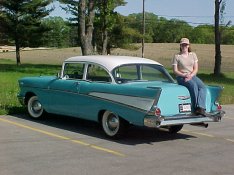Jim Chinn said:
I think if one uses cars as a metaphor, an American Motors Rambler might fit a B&J more aptly. Awkward, ugly and underpowered, but still got you were you needed to go.
Nah, Jim. It's a taxi cab.
With the Orbit, you got a newer design than the 2D,
( and a far better camera than the Korona and Seneca,
which were intended as cheap alternatives to Kodak or Ansco, nothing more ! )
The Orbit was easier to manufacture, so it was cheaper.
It could be ASSEMBLED, not crafted,
and it fit the demands of the WW2 / post-WW2 world.
Making a camera from 1945 - 50 technology made a lot of sense,
and when it was the basic camera in a photographer's toolbox
it was a great design which could be paid for with the income a small town shooter could expect to make.
At it's best, B&J was a one-stop supplier of all things photographic, from Cooke and Schneider to a variety 'house brand' stuff ( some good, some quite dodgy ). It allowed a small town camera shop access to all manner of goods, and it served little studios quite well.
The Orbit gave a local shooter a 5x7 portrait camera,
and inexpensive sliding back and roll holder
( which did a very good job, thanks ).
You could put a 150 Symar on your Orbit
and shoot 5x7 groups in the studio,
( with the sliding back, of course )
switch to the roll back to do head and shoulders,
and later, color portraits.
For tighter shots, remove the front cell of the Symar and have a nice, tight portrait look.
You could furnish your studio easily, all from B&J.
Remember, the post WW2 years saw LOTS of guys who had learned photography in the service set themselves up as 'pros' when the war was over.
There was a new middle class,
consumers had money ( which had never been the case before ! )
and there was a good market for small studios !
THAT is the world B&J served.
( The Deardorff was simply made for a different market -
not snobby amateurs, but pros making different pictures )
.




